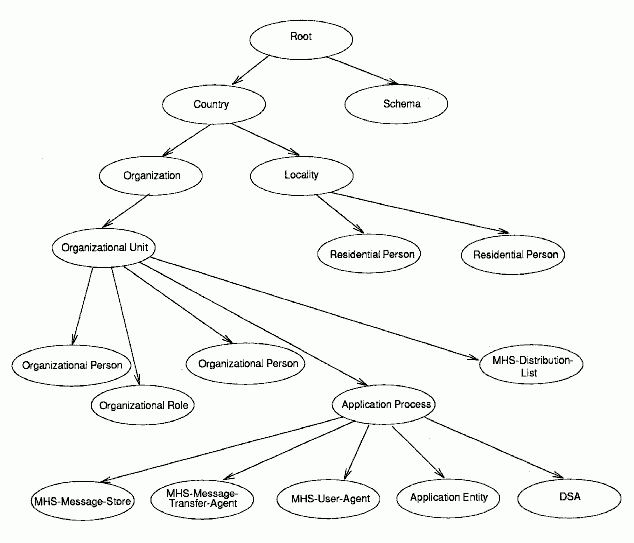
The SRT specifies the relationship of object classes in the structure of the directory. The SRT supplied with the GDS standard schema contains the entries shown in the following below.
Structure Rule Table Entries
| Rule Number |
Superior Rule Number |
Acronym of Naming Attribute | Acronym of Structural Object Class |
| 1 | 0 | CN | SCH |
| 2 | 0 | C | C |
| 3 | 2 | O | ORG |
| 4 | 3 | OU | OU |
| 5 | 4 | CN | ORP |
| 6 | 4 | CN, OU | ORP |
| 7 | 4 | CN | ORR |
| 8 | 4 | CN | MDL |
| 9 | 4 | CN | APP |
| 10 | 9 | CN | APE |
| 11 | 9 | CN | DSA |
| 12 | 9 | CN | MMS |
| 13 | 9 | CN | MTA |
| 14 | 9 | CN | MUA |
| 15 | 2 | L | LOC |
| 16 | 15 | CN | REP |
| 17 | 15 | CN, STA | REP |
For example, the object class Organization (abbreviated with the acronym ORG in the SRT) has a superior rule number of 2, indicating that it is located in the DIT beneath the object class Country (C), which has a rule number of 2. Organization Unit (OU) is located beneath Organization because it has a superior rule number of 3 and so forth.
The SRT only contains structured object classes; that is, classes that form branches in the DIT. Other object classes, such as abstract and alias classes, are not included.
The SRT specifies the attribute(s) used to name entries belonging to each object class. These attributes, called naming attributes, are used to define the RDN and therefore the distinguished name of directory entries.
The following figure shows the structure of the DIT as defined by the SRT of the GDS standard schema.
SRT DIT Structure for the GDS Standard Schema
